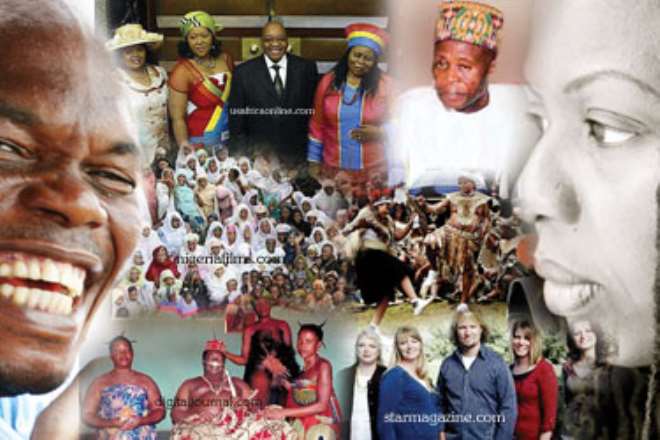Marriage: Polygamy good for men, bad for women
Although Christianity and the constitution substantially outlaw polygamy, it is still a popular system of marriage as Islam and traditional religion encourage it at various levels. While Kogi State-based Abubakar Masaba is, however, currently the reference point with his 86 wives, a study has highlighted how the practice shortchanges women, reports Eniola Akinkotu
In modern society, the conventional system of marriage is the union between a man and a woman. In fact, many scientists, feminists and activists support monogamy, not only because it represents gender equality, but because it also promotes intimacy between spouses. Many claim that in a world plagued with HIV/AIDS and many other sexually transmitted diseases, monogamy is the best form of marriage. However, a new research has shown that men who practise monogamy experience less sexual pleasure than men who practise polygamy.
The research reveals that scientifically, polygamy is good for men but bad for women. The research shows that while polygamists have many children, polygamy has a contrary effect on women involved. For every wife added to the fold, the average number of children per wife dropped by one. This implies that women who are married into polygamous homes have fewer children than women in monogamous ones.
”The more wives a woman's husband has, the fewer children she is going to have personally,” says Michael Wade, a biologist at Indiana University Bloomington, who conducted the research. ”That's interesting, and evolutionary biologists would say then that polygamy is good for males and may be not so good for females.”
Wade and his colleagues reported their findings in the March 2011 issue of the journal, Evolution and Human Behaviour. Wade conducted the research by studying the history of members of the Latter Day Saint movement in restorationist Christianity most commonly known as Mormons. Wade observed the Mormon shift from polygamy to monogamy in the 1800s and concluded that the decision by these Christians to eschew polygamy and practise monogamy reduced sexual pressures on men by more than half.
The change closed the reproductive gap between men with many wives and men with none. It also brought men's competition for wives in line with wives' competition for husbands.
According to Wade, Mormons make an excellent test case for evolutionary biologists for two reasons. First, they keep precise genealogical records. Second, Mormons are a rare example of a group of people who changed their mating practices.
In 1862, the United States made polygamy illegal in its territories, including the Mormon stronghold of Utah. In 1890, the Mormon church issued a declaration ending the practice of polygamy. Of married Utah men born in 1833, almost 18 per cent had multiple wives, Wade and his colleagues estimated. But a few decades later, less than one per cent of married men were in polygamous relationships.
”Here, with this single population there's a change, an externally driven change, in the system of mating from polygamous to monogamous,” Wade says. ”And even better, nothing else changes. They don't change their lifestyle, they don't change what they eat, or where they live.”
The researchers decided to find out how the change affected the evolutionary pressures on Mormon men and women, particularly sexual selection, in which there is competition between males (or females) to win a mate. It's this pressure that explains a male peacock's glitzy tail. Polygamy exacerbates such sexual selection. After all, for every man with five wives, there are four men with no wives at all. Thus, the multiple-wife system separates men into those with huge amounts of offspring and those with no children at all.
”The bigger that difference, the stronger selection is,” Wade said.
To measure selection, the researchers pulled genealogical data on almost 150,000 men and women born between 1830 and 1894 and almost 635,000 of their offspring from the Utah Population Database — a sample size 18 times larger than those of all previous studies on the topic combined. The researchers used US Census Bureau data to round out their estimates of the number of people who never had children. They also corrected for ”serial monogamists,” or people who had been widowed and remarried, but weren't involved in polygamous relationships.
Predictably, the men who acquired lots of wives also produced more children. For each additional spouse, a man could expect about six more children. Each wife in the relationship could expect to produce an average of one fewer child for every additional wife.
When polygamy was outlawed, the reproductive gap between successful polygamous men and wife-less singletons plummeted by 58 per cent, the researchers found.
”If you only have one partner, the maximum number of offspring for the male is going to be the same as the maximum for the females,” Wade says. So the end of polygamy brought the genders into line, he adds. ”The variation from one male to the next with monogamy becomes almost equal to the variation from one woman to the next with monogamy.”
That's no surprise, said Henry Harpending, a professor of anthropology at the University of Utah, who was not involved in the research. Historical Mormons are particularly interesting to study, Harpending told LiveScience, because there is little question as to the paternity of offspring. In other polygamous cultures, Harpending adds, marriage doesn't always mean sexual exclusivity, making similar studies difficult.
”This is the best that has ever been done, and it's very impressive,” Harpending says of the study. However, he cautions, the variation in reproductive success seen in the Mormon population doesn't necessarily mean that evolutionary selection is taking place.
”The guys that have three wives may have three wives because it's simply random or because they're better at something,” Harpending notes. ”If it's because they're better at something, then that's changing the gene pool and that's selection. If it's just random — my Uncle Charlie helped me buy a farm and I got three wives — then that doesn't change the gene pool.”
There are other details in the findings - like the cost of extra wives for women, Harpending says. Perhaps, those women's husbands are older and less fertile, or perhaps, they'd previously been widowed and had thus missed a potentially fertile year, he explains.
”What I'd like to see done is life histories of women, so we could ask, 'What's the effect of being widowed?' 'What is the per-year birth rate for a woman, age-corrected and correct for husband's age?'” he notes. ”There are so many questions.”
Latest News
-
 "If You're For Me, I Am For You" - Cubana Chief P
"If You're For Me, I Am For You" - Cubana Chief P -
 "3 Days To Go" - Femi Adebayo Urges Fans To Get S
"3 Days To Go" - Femi Adebayo Urges Fans To Get S -
 "Stop Asking Me Questions About Speed Darlington"
"Stop Asking Me Questions About Speed Darlington" -
 "Benue Is The Most Underdeveloped State I've Ever
"Benue Is The Most Underdeveloped State I've Ever -
 Stan Alieke Urges Young Professionals To Take Lin
Stan Alieke Urges Young Professionals To Take Lin -
 Chizzy Alichi Teases Fans With Baby Reveal, Promot
Chizzy Alichi Teases Fans With Baby Reveal, Promot -
 "I'm Not Wearing Makeup From July 4th Till Decemb
"I'm Not Wearing Makeup From July 4th Till Decemb -
 "Stop The Challenge Of Mocking Kids With Down Syn
"Stop The Challenge Of Mocking Kids With Down Syn -
 Regina Daniels Celebrates Sons As They Mark Birthd
Regina Daniels Celebrates Sons As They Mark Birthd -
 Speed Darlington Threatens To Sue NAPTIP For Defam
Speed Darlington Threatens To Sue NAPTIP For Defam














